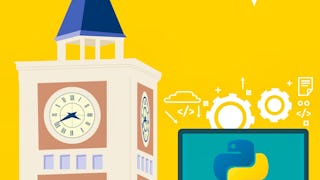Este curso te dará ágil acceso a las estructuras de datos principales del lenguaje de programación Python en su versión 3.0.

Enjoy unlimited growth with a year of Coursera Plus for $199 (regularly $399). Save now.

Estructuras de datos en Python
This course is part of Aprende a programar con Python Specialization

Instructor: Agustin Olmedo
19,402 already enrolled
Included with
(419 reviews)
What you'll learn
Utilizar strings
Comprender las diferentes estructuras de datos que provee Python
Comprender cómo se trabaja con archivos
Comprender qué son las excepciones y el uso de los decoradores
Skills you'll gain
Details to know

Add to your LinkedIn profile
See how employees at top companies are mastering in-demand skills

Build your subject-matter expertise
- Learn new concepts from industry experts
- Gain a foundational understanding of a subject or tool
- Develop job-relevant skills with hands-on projects
- Earn a shareable career certificate

There are 4 modules in this course
En este módulo abordaremos los siguientes contenidos: Primero trabajaremos con los strings (o cadenas de caracteres), manipulando los strings. Además, veremos los métodos que define el tipo string. Luego trabajaremos con la librería string que forma parte de la biblioteca estándar de Python. Finalmente, aprenderemos a utilizar la librería datetime, para trabajar con fechas, horas y fechas y horas dentro del programa.
What's included
10 videos6 readings7 assignments
Avanzamos al módulo 2 de contenido. En esta semana nos abocaremos a comprender y utilizar las excepciones. Aprenderemos a manejar excepciones, a lanzar excepciones y a crear nuestro propios tipos de excepciones. Luego aprenderemos a trabajar con archivos: leyendo y escribiendo archivos en el sistema de archivos de nuestra computadora. Además, utilizaremos dos formatos de archivos muy populares para trabajar con sistemas: el formato JSON y el formato CSV.
What's included
9 videos3 readings7 assignments
Llegamos al módulo 3 del curso. En esta semana trabajaremos con las listas: manipulando listas y utilizando los diversos métodos que provee el tipo lista. Además, identificarás y trabajarás sobre sus diversos usos: pilas, colas, listas por comprensión y matrices. Luego, veremos en detalle algunos métodos para buscar elementos en las listas y también aprenderás diversas formas de ordenar los elementos de una lista. Además, aprenderás a utilizar el tipo conjunto y comprenderá cuando utilizar un conjunto en lugar de una lista.
What's included
9 videos1 reading7 assignments
Llegamos al último Módulo del curso. Felicitaciones por haber llegado hasta aquí. En esta semana podrás trabajar con las tuplas: creando, manipulando, empaquetando y desempaquetando tuplas. Luego trabajaremos con la estructura de datos más potente de Python: los diccionarios. Veremos cómo crearlos, manipularlos y recorrerlos. Además utilizarás los distintos métodos del tipo diccionario. Abordaremos la definición de generadores, comprenderás cómo crearlos y cómo y cuándo conviene utilizarlos. Finalmente, aprenderás qué son los decoradores y veras como crear y utilizar decoradores en tus programas.
What's included
8 videos4 readings7 assignments1 peer review
Earn a career certificate
Add this credential to your LinkedIn profile, resume, or CV. Share it on social media and in your performance review.
Instructor

Offered by
Explore more from Software Development

Universidad Austral

Universidad Austral

Universidad Austral
Why people choose Coursera for their career




Learner reviews
419 reviews
- 5 stars
71.12%
- 4 stars
19.33%
- 3 stars
5.25%
- 2 stars
2.38%
- 1 star
1.90%
Showing 3 of 419
Reviewed on Oct 2, 2020
Es un buen curso para principiantes, pero el contenido podria ser más profundo y poner mas ejemplos para realizar con el programa, de forma que la tarea final no se haga tan cuesta arriba.
Reviewed on Nov 13, 2020
El curso me parece muy bueno, solo pienso que debería tener un poco más de profundidad en las actividades de programación, entendiendo que es el segundo de la ruta de Python. Gracias por su trabajo!
Reviewed on Nov 6, 2020
Muy buen curso me parecido que debe ponerse mas enfasis en ejemplos del mundo real en el que se puedan utilizar algunos de los conocimientos otorgados, por lo demas excelente material

Open new doors with Coursera Plus
Unlimited access to 10,000+ world-class courses, hands-on projects, and job-ready certificate programs - all included in your subscription
Advance your career with an online degree
Earn a degree from world-class universities - 100% online
Join over 3,400 global companies that choose Coursera for Business
Upskill your employees to excel in the digital economy
Frequently asked questions
To access the course materials, assignments and to earn a Certificate, you will need to purchase the Certificate experience when you enroll in a course. You can try a Free Trial instead, or apply for Financial Aid. The course may offer 'Full Course, No Certificate' instead. This option lets you see all course materials, submit required assessments, and get a final grade. This also means that you will not be able to purchase a Certificate experience.
When you enroll in the course, you get access to all of the courses in the Specialization, and you earn a certificate when you complete the work. Your electronic Certificate will be added to your Accomplishments page - from there, you can print your Certificate or add it to your LinkedIn profile.
Yes. In select learning programs, you can apply for financial aid or a scholarship if you can’t afford the enrollment fee. If fin aid or scholarship is available for your learning program selection, you’ll find a link to apply on the description page.
More questions
Financial aid available,
¹ Some assignments in this course are AI-graded. For these assignments, your data will be used in accordance with Coursera's Privacy Notice.

